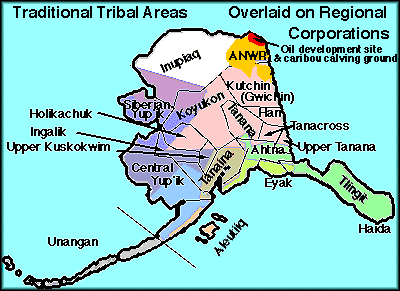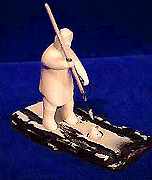 |
|---|
|
As the overlay shows, there is a rationale to the organization of Alaska's hundreds of Native communities into regional Native development companies. Roughly, the company regions correspond to traditional territories of the tribes. See (if willing to wait for slow load) slightly different territories on an an Alaska Native Education program languages map. Five Landless Tlingit Tribes These tribes were left out of the Alaska native Claims settlement. They have no land, no right to subsistence fishing and hunting. Well-known Tlingit artist Jesse Cooday helped to design these pages, which contain a real (not as told to bzabytalk) traditional story by an elder. Don't forget the "What you can do" section. Alaska's Towns and Villages Ingenious database where you can look up much (all text) info. Not limited to Native villages, but there are so many of those they dominate the database. Get the names of the towns at this mapsite, look up info about them here. Alaska's Native Cultures Once-over shallowly, by a tourist agency. No pix.
Point Hope is a historic Native community in Alaska. In the late 1950's, the Bureau of Land Management issued the Atomic Energy Commission (AEC) a license for a cockeyed and enormously dangerous scheme to use 1600 square miles around Point Hope to blast out a deep water seaport with nuclear exposives. No one ever consulted the village residents who would have to have been movd away for the blast (no environmntal considerations either). In 1961, the president of the Point Hope Village Council wrote to the Association of American Indian Affairs (AAIA) a private foundation formed to help Indians. AAIA provided funds and coordination for inter-village meetings at which rights were explained, and common solutions agreed upon. 12 regional associations of Alaska Natives were formed and began the legal process to pursue their land claims (resulting in the Alaska Native Claims Settlement of 1971). The small group of Native people of Point Hope, a remote and isolated Arctic village, played a very important role beyond the start of a land claims process for all the treatyless peoples of Alaska. Nuclear blasting in the seas of the fragile north, where currents circulate betwen the continents would have had incalulably dangerous environmental effects, probably much broader than on the ecology just of the far north, affecting the oceans, and perhaps worldwide weather and climate patterns. Point Hope began the action that stopped this -- but the area was then used as a dumping ground by the AEC for hazardous nuclear wastes. There are many indications this was an intentional experiment to try to discover the effects (i.e. how bad the effects would be) on the biota, including the Native people OF the area.
Profiles of Alaska Inuit-Aleut Communities -- Bristol Bay , AK villages Region Page by one of the regional development corporations. Cook Inlet Tribal Council, Alaska. Not much info, tribal contacts, programs. Native Regional Development Corporation page.
Chugach Regional Company's server they appear to be trying to be access providers. the server contains alaska JobNet, a shoping mall, and that's about it. Alaska North Slope Borough School district Website They do a lot of distance education necessarily. Many of the communities are entirely or largely Inupiaq students
Alaska Online: project of 200 students at D'zantiki Heeni (Tlingit) middle school, Juneau, intresting pags with student work, reportage, art. Alaska Native Education at Lathrop High (Fairbanks). 120 students -- including some from tribes far south -- participate in the program. They researched Alaska Native tribes and posted pages of info and links about several of them STORIES, ART, CULTURE The Origin of Light (Alaska Inuit) -- Australian server world stories/myths collection. Submitted in 1995 by students from the Alaska Native Network (Inuit), managed by Laura Thorpe. Marie Oldfield, Tsimshian-Haida demonstrates craft with some of her paintings and drawings on show here A Story of a Shaman Anthros can make just about anything dull. Shamanism -- bunch of anthros academic writings fed through the grinding mill of a PR person for tourism. The word 'shaman' doesn't exist in any Indian or Native language; anmthros made it up. Two Old women: A Legend of Courage and Survival -- Book review. The Inupiat Eskimo of Arctic Alaska -- Ethnograhic Portraits from Arctic Circle cultural materials Tlingit Dancers Brief interview with two of them about the meanings of dances, the outfits, etc. No pix. Tlingit carving related to Northwest Coast history. No pix. Native Alaskan Plants and their uses, high-school botany student work The Inside Passage Boat trip along the skinny southern panhandle of Alaska, with some shallow Indian info about Tlingit, Haida and other NWC tribes. No pix. |
 The Arctic National Wildlife Refuge -- a calving place for the last remaining large herd of caribou -- barely escaped being opened for oil and gas development by U.S. Congress in the fall of 1996. The issue will continue to arise, one presumes until permission is conferred and the wildlife refuge is invaded. Most of the environmental deiscussion of this ignored the viewpoints of those who will be most affected by disturbances to the herd's calving ground. For these people are the Vuntut Gwich'in, who live above the Arctic Circle in Canada. International boundaries are meaningless to the animals, who make a great circle migration between the U.S. and Canada seasonally, every year.
The Arctic National Wildlife Refuge -- a calving place for the last remaining large herd of caribou -- barely escaped being opened for oil and gas development by U.S. Congress in the fall of 1996. The issue will continue to arise, one presumes until permission is conferred and the wildlife refuge is invaded. Most of the environmental deiscussion of this ignored the viewpoints of those who will be most affected by disturbances to the herd's calving ground. For these people are the Vuntut Gwich'in, who live above the Arctic Circle in Canada. International boundaries are meaningless to the animals, who make a great circle migration between the U.S. and Canada seasonally, every year.